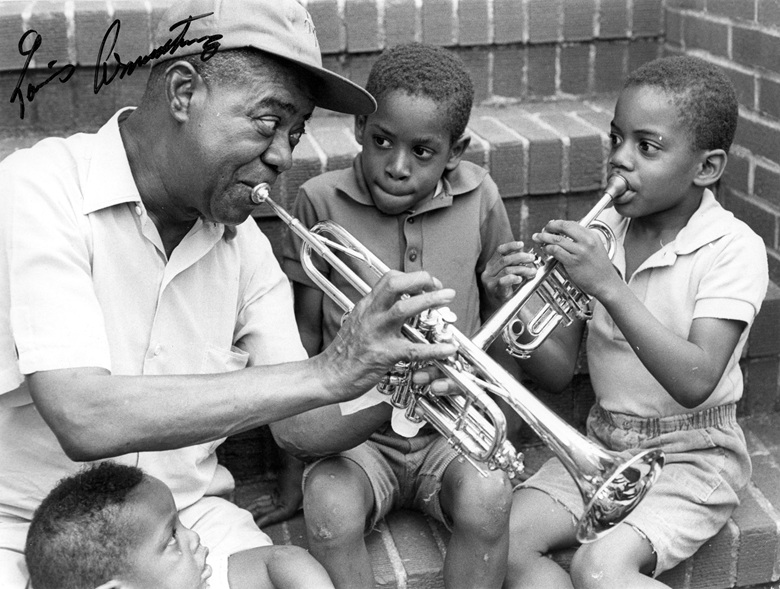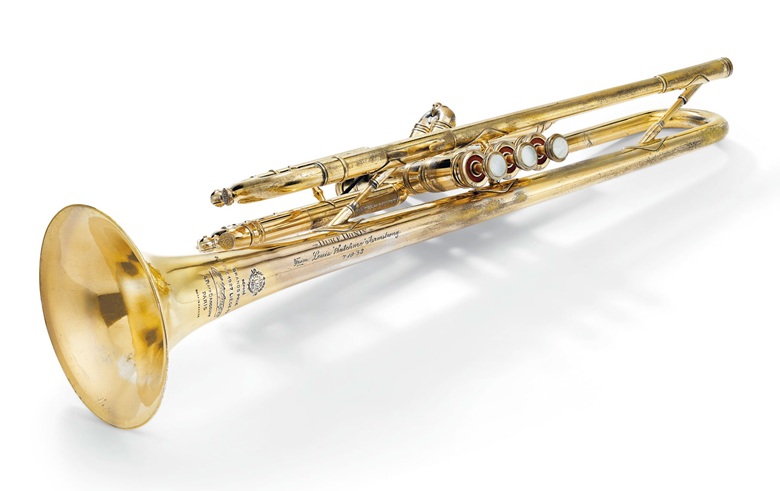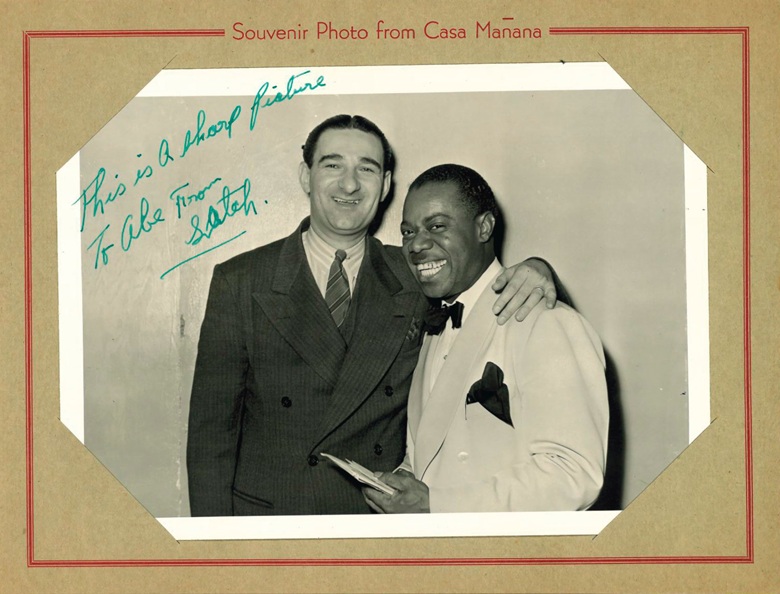What a wonderful world: Satchmo’s trumpet
An inscribed Selmer trumpet, used by jazz legend Louis Armstrong at the height of his powers in the early 1950s, is offered in The Exceptional Sale on 14 October
Born in 1901, Louis Armstrong blazed a path through mainstream American music in the early 1920s, transforming the improvised hot jazz of his impoverished New Orleans childhood into a thrilling new idiom that changed music forever.
With his unmistakeable gravelly voice, phenomenal lung power (he was famous for being able to hit 200 high Cs) and virtuosic swing, Armstrong took jazz performance to new heights. The poet Langston Hughes dubbed him ‘almost the whole story of orchestral jazz in America’.
Other fellow musicians called him ‘Satchel Mouth’— later shortened to ‘Satchmo’ — because of his huge grin, which he used to great effect, mesmerising the rowdy audiences of his early years as a rising star in Chicago and New York.
Louis Armstrong with neighbourhood children on the front steps of his home in Queens, New York, circa 1970. Archival image courtesy of the Louis Armstrong House Museum. Photo: Chris Barham
By the 1930s he had performed with swing bands, appeared in feature films and become a huge star. Then in the 1950s he returned to his roots with the New Orleans sextet Louis Armstrong and His All Stars, touring the world and bringing jazz into more people’s lives in more countries than any musician before him. In 1965 he even crossed the Iron Curtain to play in communist East Germany, earning him the nickname ‘Ambassador Satch’.
It is likely the trumpet was used on The California Concerts, a live album recorded in 1951 at the Pasadena Civic Auditorium
Armstrong bought his first cornet aged 15, a battered $10 affair ‘all bent up, holes knocked in the bell’, as he later recalled, but in Armstrong’s hands, it proved good enough for the riverboat circuit on the Mississippi. The trumpets that followed were not much better, until the late-1920s, when Armstrong was so successful that he could commission trumpets to his own specifications.
In the early 1930s he discovered the trumpets made by Henri Selmer Paris, a distinguished French brass and woodwind company established in 1880.
‘Henri Selmer (1858-1941) had studied at the Conservatoire de Paris in the late-19th century and was incredibly innovative when it came to brass and woodwind instruments,’ explains Becky MacGuire, a senior specialist at Christie’s. ‘The company developed the “balanced action” trumpet model in 1933 and Louis Armstrong was one of the first musicians to play it. Today, these instruments are often known as “Armstrong trumpets”.’
A Selmer model 19 Balanced Action Medium Bore Trumpet, Henri Selmer, Paris, 1948. Brass with worn gold plating. Inscribed ‘DUKE DONIN/from LOUIS “SATCHMO” ARMSTRONG/7/10/53.’ With modern case. Offered together with a cotton handkerchief inscribed in Louis Armstrong’s characteristic green ink, ‘To Joella/Louis Armstrong/Satchmo’. Estimate: $60,000-80,000. Offered in The Exceptional Sale on 14 October 2020 at Christie’s in New York
According to MacGuire, Armstrong would play his instruments for about five years, then give them away as presents. The trumpet offered in The Exceptional Sale in New York on 14 October was given to Duke, the son of Abe and Frances Donin, two jazz aficionados whom Armstrong and his wife Lucille had met in Los Angeles in the 1930s.
‘The Donins probably first heard Armstrong at Culver City’s Cotton Club in the 1930s,’ says MacGuire. ‘Louis had gone to California to play the clubs and to try to break into Hollywood movies.’
They became great friends: the Donins can even be heard joking on Armstrong’s reel-to-reel tapes. They were also guests at his 70th-birthday tribute celebrations at the Shrine Auditorium.
A photograph of Abe Donin, the father of Duke Donin, and Louis Armstrong inscribed by Armstrong with the words: ‘This is a sharp picture. To Abe from Satch’
The trumpet is engraved with the words ‘Duke Donin/from Louis “Satchmo” Armstrong/7/10/53’, which adds to its rarity — only a handful of Armstrong trumpets were ever inscribed. A similar model from 1946 is held at the Smithsonian National Museum of African American History and Culture in Washington, D.C.
It is likely that the Donin trumpet was used by Armstrong on The California Concerts, a live album recorded in 1951 at the Pasadena Civic Auditorium.
‘This was a time in his life when he was totally in control,’ says MacGuire. ‘His distinctive scat singing in that fabulous gravelly voice, his soaring and confident trumpet solos, the fluidity with which he swung in and out of his ensemble: this was the Louis Armstrong that made American jazz.’
Sign up today
Christie’s Online Magazine delivers our best features, videos, and auction news to your inbox every week
Subscribe
Armstrong died in 1971, leaving a tremendous legacy. The late jazz trumpeter Abram Wilson (1973-2012) summed up his influence on later musicians: ‘He was a very noble figure, a musician of perseverance. He opened the door for all of us to walk through and set the parameters for jazz trumpeters all over the world.’
17 September 2020
Pop Culture & Collectibles | Video
Highlighted sale
[
](https://www.christies.com/en/auction/the-exceptional-sale-28775/)
[
The Exceptional Sale
New York
14 October 2020
](https://www.christies.com/en/auction/the-exceptional-sale-28775/)Learn more
AddThis Sharing Buttons
Share to FacebookFacebookShare to TwitterTwitterShare to PinterestPinterestShare to WeChatWeChatShare to PrintPrint
Get the best stories from Christies.com in a weekly email
Sign up now
*We will never sell or rent your information. Privacy Policy
Related feature
[
5 minutes with... Miles Davis’s ‘Moon and Stars’ trumpet
Read more
](https://www.christies.com/features/The-Miles-Davis-blue-lacquer-moon-and-stars-trumpet-10041-3.aspx?sc_lang=en)(function ($) { $(function () { $(‘.floating-module.related-feature’).css(‘top’, ($(‘.module.landscape-visuals.article’).height() - $(‘.floating-module.related-feature’).height()) / 2); }); })(jQuery);







